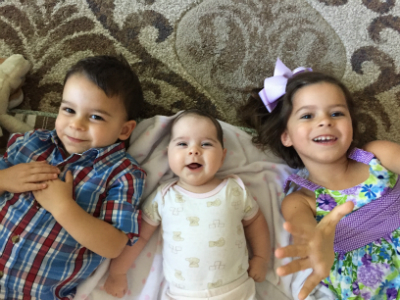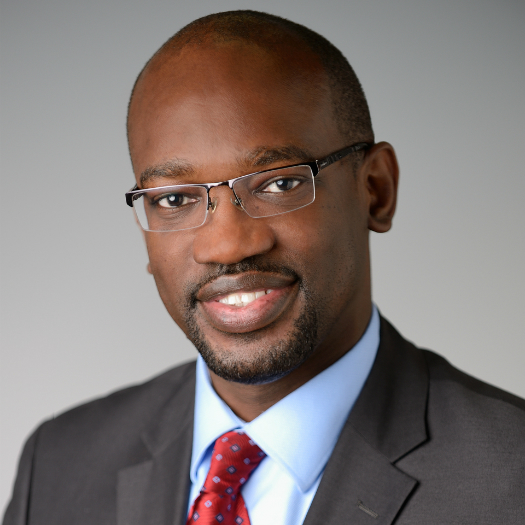
Darcy's Story

"When can you get us in?”
Rachel Murphy remembers the urgency of the family’s question when they first called Children’s National Hospital.
Darcy, the youngest of the couple’s three children, had suffered her first seizure within the first 12 hours of life. After that came a dizzying odyssey in and out of emergency departments and neonatal intensive care units (NICUs) as two different care teams tried to figure out what was wrong with their baby girl. Finally, Darcy was diagnosed with polymicrogyria, a condition that occurs when the brain develops too many folds.
Rachel and Ryan Murphy braced for significant developmental delays, infantile spasms and epilepsy. Through the kindness of Ryan’s employer, the family replaced a scheduled two-year work placement in Africa with a move to the Washington, D.C., region, where there are more options for children with complex care needs. TRICARE, their insurer, permits families to choose any facility in the first 60 days of the child’s life. The Murphy family picked Children’s National due to its world-class reputation and expertise in treating epilepsy.
When the doctor, Julie Ziobro, spoke with the Murphys, she said she would find a way to see them as soon as they could arrive. The Murphy family filled a U-Haul with their belongings, drove overnight and pinned their hopes and dreams for Darcy’s future on that initial visit.
They learned that Darcy had been misdiagnosed. Instead, Children’s National neurology experts found that Darcy was born with hemimegalencephaly, a rare malformation affecting one of the brain’s two hemispheres. For children with this condition, the malfunctioning hemisphere grows much too large, lays down an expanded network of vessels to commandeer a disproportionate supply of blood and triggers damaging seizures that resist treatment by medications.
Over a 24-hour period, Neurologist Taeun Chang, M.D., monitored an electroencephalogram capturing electrical impulses that Darcy’s brain cells used to communicate with each other while the NICU team monitored her vital signs. In the tangle of electrical storms, Dr. Chang spotted a 10-minute window of calm, like a tiny spot of blue amid a sky filled with dark clouds. That gave Dr. Chang hope against the odds that increasing Darcy’s doses of medication might quiet the seizures.
“I had never seen a seizure before,” says Rachel, 29. “For my family and friends, this has all been foreign to us.”
Today, terms like hemimegalencephaly and the “plasticity” of an infant’s brain roll off Rachel’s tongue.
“When it’s your baby, you’re in a sink-or-swim mode. Oh my gosh,” she says. “We were in the Children’s NICU for three weeks. Dr. Chang visited daily with updates on Darcy.” Rachel says she wrote down everything to tell Ryan, 33, who remained at the family’s new home, unpacking boxes and caring for their two other children, Rowan, 3 1/2, and Callum, 2.
The clinical care team tried overnight to overload Darcy’s system on seizure medications and confirmed that the volume of medicine the infant was given made no significant difference in tamping down seizures. Dr. Chang explained Darcy’s remaining options including undergoing a hemispherectomy, a dramatic surgery that is the most successful way to end hemimegalencephaly-related seizures and preserve the function of the healthy half of the brain.
“Every month there are uncontrolled seizures there are IQ points these kids are losing,” Rachel says, in explaining why the surgery was a more viable option than inducing coma or simply bringing Darcy home.
The challenge: Darcy was only five weeks old. Few healthcare teams perform hemispherectomy on infants that young.
With the Murphy’s consent, the Children’s National care team used embolization, or controlled strokes, to shield the working half of Darcy’s brain from the damaging effects of the malfunctioning hemisphere. In the first embolization, they stroked nearly 70% of Darcy’s left hemisphere. After a week, they planned to perform a second embolization but decided against it because a small leg clot had formed where the first procedure was done.
Darcy did just fine on seizure medications from that point onward, as the family waited for her to grow old enough for the hemispherectomy. Prior to the embolization, she would jackknife during seizures, grunting as she raised her arms and kicked her legs. After the procedure, her seizures were so infrequent and mild that a casual observer could miss the five to 10-second events.
Darcy was three months old when Neurosurgeon Chima Oluigbo, M.D., (Dr. O) performed the functional hemispherectomy, expertly disconnecting the remaining parts of her left hemisphere, like a remote little island, to neutralize its ability to trigger seizures. “Dr. O said this is the prime age to do this because of the plasticity in the right side of her brain. Darcy’s brain hasn’t developed specific responsibilities. They’re not taking anything away; she hasn’t learned those things yet,” Rachel adds.
The Murphys knew there was a chance Darcy would experience lingering weakness on her right side, which led Rachel to worry about whether the infant would be able to do things other babies do. Instead, when Darcy smiles, it’s a full Mr. Kool-Aid grin. Her big sister delights in surprising her with a playful “boo” to elicit a full-bellied laugh.
“She’s our miracle baby,” Rachel says.
Now that the seizures have stopped, Darcy makes eye contact and no longer winces from muscle soreness when she’s caressed. She likes to suck her fingers and makes do with the fingers on her left hand. For now, she uses her left hand to guide her right hand to her mouth, sucking her fist, but appears determined to unfold her right fingers. The loss of a functioning left hemisphere may mean future tutors for math and reading, but Rachel says their family is OK with that.
“Dr. Chang was very aggressive when treating Darcy. I compliment her on that every time I see her. When I go online to read stories about kids who ultimately had hemispherectomy surgery, they struggled with seizures for the first year of their life because their doctors kept trying to treat it with medications,” Rachel says.
For much of the time that Darcy was in Children’s NICU, Rachel breastfed her. While Darcy slept, Rachel appreciated the one-on-one quiet time. She simply rocked Darcy and had the chance to read her first novel in quite some time.
“Doctors would poke their heads in just to say hi. A couple of nurses offered to babysit. I’m Facebook friends with three,” Rachel says. “It’s nice when you’re in a hospital that long to make connections. It was not just people doing their job. They cared for my baby the way a friend would. It was amazing.”
Related resources
A novel way to treat intractable epilepsy caused by hemimegalencephaly
Working miracles to control seizures and preserve brain power in newborns
Dr. Chang passed away in June 2022.



